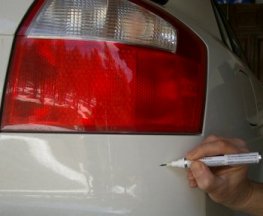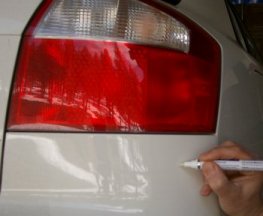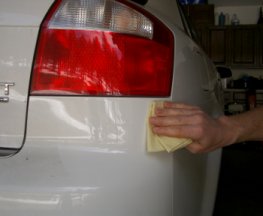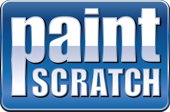How to Apply Touch Up Paint Using the Paint Pens
 |
 |
| The area is cleaned with wax and grease remover. You can also use detergent but the wax and grease remover works the best. Prime any unpainted areas using a primer paint pen. Use rubbing compound (cutting creme) to smooth the primer if necessary. Be careful if you sand the primer as you can end up making the surrounding area dull. If you do sand, wetsand using 1000 grit sandpaper with plenty of water. | The basecoat is applied. Use thin light coats and let dry between coats. Do not try to cover the scratch with one coat and remember to depress the paint pen off the vehicle to start the paint flowing. Wipe the excess paint off the tip before applying.. |
 |
 |
| Once the basecoat has dried, the clearcoat can now be applied. You can use rubbing compound (cutting creme) on the basecoat to smooth the paint before applying the clear if necessary. Be careful when applying clearcoat. You need to float it over the basecoat. Clearcoat acts like a solvent and any pressure applied will remove the basecoat. | Once the clear has dried, you can apply rubbing compound to smooth and shine the area. You should clean both paint pen tips with automotive lacquer thinner. |
Very Important!
Do not depress the paint pen directly on your vehicle. To start the flow of paint, gently tap the paint pen on a hard surface to start the paint flowing. Be careful holding the nib down! If you push and hold the paint pen down, all the paint will flow out of the tube creating a mess!
Shake the basecoat paint pen
Make sure you shake the basecoat (and midcoat if you are applying a tricoat) paint pen thoroughly.
Please note: The clearcoat paint pen does not need to be shaken.
If you have never used the paint pen before, just go slowly and keep practicing depressing the nib on the end until you can control the paint flow. Wipe of the excess paint before applying to your vehicle.
Quick Steps-Paint Pens
1) Clean the area (soap and water or wax and grease remover)
2) Apply very thin coats of basecoat.
3) The basecoat should be dry to the touch before applying the clearcoat. Apply Clearcoat over the basecoat. Be careful when applying clearcoat. You need to float it over the basecoat. Clearcoat acts like a solvent and any pressure applied will remove the basecoat.
4) Use Rubbing Compound (cutting creme) (apply with clean soft cotton only, paper products will scratch your finish) to smooth and shine the area. Always test the rubbing compound (cutting creme) on your vehicle in an inconspicuous place to check for surface compatibility and shine.
5) If this is your first time, try one small chip from start to finish before repairing other areas.
6) If you have a small scratch, we recommend using rubbing compound (cutting creme) to smooth the primer, basecoat and clearcoat. Sanding small areas can dull the existing finish. You can wetsand with 1000 grit to remove imperfections and smooth the surface but be careful as you can end up making the surrounding area dull and even sand off the original basecoat and clearcoat.
7) You should always clean the paint pen tips with automotive lacquer thinner.
Fixing Paint Chips and Scratces
The maximum size you should attempt to repair with a paint pen is up to the size of a pencil eraser. Anything larger should be spray painted. The paint pen was not designed to be brushed over a larger area. It is instead used to apply paint to small chips and can also be used on scratches.
Temperature
Make sure the temperature is at least 40°F degrees. Paint pens can be applied in much colder conditions than spray can. The paint can dry very quickly in warm weather (above 70 degrees). The whole point behind practicing is to see how quickly the basecoat, (midcoat if you are doing a tricoat) and clearcoat will dry. Normally we recommend letting the paint dry overnight at each step, but often you can do all the steps within an hour. Do not practice on your vehicle!
Tricoats (basecoat/midcoat/clearcoat)
Make sure you read the additional instructions here for tricoats.
Clean and Protect the Area
Wash the area with soap and water, then use a wax and grease remover or equivalent product (some painters have suggested tar and insect remover, available at the supermarket) before starting the project. You may wish to use masking tape (automotive quality only!) all around the scratch or chipped area to prevent accidentally marring the surface.
Rust
The first thing to determine is if the scratch has started to rust. We are talking about a surface scratch and not rust that is bubbling up beneath the paint, as this is too far-gone for touch-up paint! If the area is rusty, you should take a little extra effort to remove all traces of rust using 220 grit sandpaper or a wire brush. Follow this with Mar-Hyde One-Step Rust Converter (sold on our site) and apply this to the bare metal. Just follow the directions on the product.
Applying Primer/Paint or Clearcoat with the Paint Pen
To start the paint flowing in the paint pen, depress the nib on a hard surface until you see the paint start to flow. Do not do this on your vehicle as you could end up with too much paint on the tip of the pen. Wipe the excess paint off and apply thin coats allowing each coat to dry for twenty minutes. If you need more paint, do not depress the nib on your vehicle to release more paint, do it off the vehicle somewhere. The paint pen is very nice to work with because you can really control the thickness of the paint and avoid paint blobs completely. Do NOT use enamel primer!
Primer
If you have an unpainted surface, either bare metal, plastic, rubber, etc., APPLY PRIMER! Primer is made to stick to unpainted surfaces and paint is designed to stick to primer! Primer can also be used to fill small imperfections in the surface. Clean the area of all dust with a tack rag and apply primer to the unpainted surfaces. Let the primer dry thoroughly before applying the color coat. If the primer is rough, use the rubbing compound (cutting creme) to smooth the surface. If you sand the scratch, the sandpaper will dull the surface so be very careful.
Applying the Basecoat
The Basecoat is the actual color you have ordered. Apply several thin coats of paint to build up the chip to the same depth as the surrounding surface. If the paint pen becomes dry, do not depress the tip on the vehicle! Depress the tip off the vehicle and wipe off the excess. Let it dry for ten to twenty minutes between coats. Let the paint dry thoroughly before applying the clearcoat. Usually if you let the paint dry overnight, it will be dry. However, in temperatures less than 70 degrees, it can take much longer. You may sand the basecoat to remove imperfections by using 1000 grit wet and dry sandpaper and wet sand the area smooth using plenty of water. You can also use rubbing compound (cutting creme) as it won't dull the surrounding finish.
Clearcoat
The basecoat should be dry to the touch before applying the clearcoat. Apply several thin coats of the clearcoat, drying for ten to twenty minutes between each coat. Be careful when applying clearcoat. You need to float it over the basecoat. Clearcoat acts like a solvent and any pressure applied will remove the basecoat. Let the area dry and use a good quality automotive rubbing compound to polish the area. You may sand the clearcoat to remove imperfections by using 1000 grit wet and dry sandpaper and wet sand the area smooth using plenty of water. You can also use rubbing compound (cutting creme) as it won't dull the surrounding finish. You can let the clearcoat dry overnight but if the temperature is cold (less than 70 degrees F), it can take much longer. Make sure you use a clean soft cotton fabric such as a T-Shirt. Wait 30 days before applying automotive wax. Don't use a bath towel, wash cloth, etc.
Please note: The paint will darken when you apply the clearcoat. If this is an issue, the only solution would be to spray the paint as then you can have some control of how light and dark the paint and clearcoat go on.
Using the Rubbing Compound (cutting creme)
Rubbing compound (cutting creme) is applied to the entire area to make the area smooth and shiny. Let the clearcoat dry for at least three days before using the rubbing compound. Use a clean, very soft cloth like an old tee shirt (for example DO NOT USE PAPER PRODUCTS as the wood fibers will scratch the finish!). Place a small quantity of rubbing compound (cutting creme) on the vehicle and use circular strokes and apply even pressure to the surface. It's almost like waxing a vehicle except the rubbing compound (cutting creme) is like an extremely fine liquid sandpaper. Buff with a clean cloth to a high gloss. (You may want to apply some paint and clearcoat on a smooth surface and practice to get the feel of it.) Sometimes lots of pressure is required to make the clearcoat shine. The rubbing compound (cutting creme) can also be applied by machine, but careful, it's very easy to burn the finish! You can get the same results by hand, it will just take a bit longer.
The rubbing compound (cutting creme) is also good for removing oxidation from your finish. Let the finish dry for a 30 days and apply a good quality automotive wax.
Shine problems
Sometimes, especially on dark colored paints, the repaired area will look hazy and/or scratched and not match the surrounding paint. If you experience this. you have two options. Purchase some automotive polishing compound locally and use this until the shine matches your original paint. You can also go to a local detail shop and have them power polish the area.
This problem can be caused by using too much pressure on the rubbing compound (cutting creme). The rubbing compound (cutting creme) is equivalent to using 1500 grit sandpaper and with enough pressure, it will scratch the original paint.
This is why we recommend going through ALL the steps before applying to your vehicle. Or practice on an inconspicuous area of your vehicle.
Waxing
Allow the finish to dry for 30 days before waxing.





